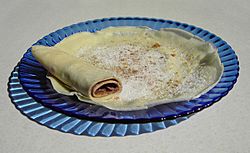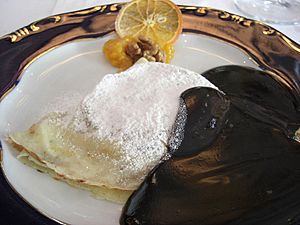Palatschinke facts for kids

Ordinary palatschinke, sprinkled with sugar.
|
|
| Alternative names | Palačinka, palacinka, palacsinta, clătite |
|---|---|
| Type | Pancake |
| Place of origin | Greco-Roman world |
| Main ingredients | eggs, wheat flour, milk |
Palatschinken are super thin pancakes, a bit like French crêpes! They come from a long time ago, in the ancient Greek and Roman worlds. Even though they started there, they are really popular today in countries in Central and Eastern Europe. You might hear them called by different names like palačinka or clătite, depending on where you are. People usually fill them with yummy sweet things, but sometimes they can be savory too!
Contents
The History of Palatschinken
Palatschinken have a very old history! They first appeared in the Greco-Roman world a long, long time ago. Around 350 BCE, ancient Greek writers like Archestratos and Antiphanes wrote about a dish called plakous.
Later, around 160 BC, a Roman writer named Cato the Elder shared a detailed recipe for a similar food called placenta. It's amazing that Palatschinken still have a name that sounds like these ancient dishes!
Where the Name Comes From
The name Palatschinken comes from the Latin word placenta. This Latin word itself came from the Greek word plakous. Both words meant thin or layered flat breads.
Over many years, the name traveled through different languages in Central and Southeastern Europe. The Austrian-German word Palatschinken likely came from the Czech word palačinka. That word probably came from the Hungarian palacsinta, which then came from the Romanian plăcintă. All these words eventually lead back to the Latin placenta!
Some people also believe the Hungarian word palacsinta might have come from an Italian word.
Different Names for Palatschinken
You'll find Palatschinken known by many names across Europe:
- In Slovak, it's palacinka.
- In Bosnian, Bulgarian, Czech, Croatian, Montenegrin, Macedonian, Serbian, and Slovene, it's palačinka or палачинка.
- In Polish, it's called a naleśnik.
- In Ukrainian, it's налисник (nalysnyk) or млинець (mlynec).
- In Russian, it's налистник (nalistnik) or блинчик (blinchik).
- In Romanian, it's clătită.
Types of Palatschinken
Central European Palatschinken are thin pancakes, very much like the French crêpes. One cool difference is that you can use the Palatschinken batter right away. For crêpes, it's often suggested to let the batter rest for a few hours.
To make Palatschinken, you mix eggs, wheat flour, milk, and a little salt to create a smooth batter. Then, you cook it in a pan with butter or oil until it's golden. Unlike thicker pancakes, Palatschinken are usually served with different yummy fillings. People often eat them for lunch or dinner.
Sweet Palatschinken Fillings
Traditionally, Palatschinken are rolled up with apricot, strawberry, or plum jam. Then, they are often sprinkled with confectioner's sugar on top.
Today, there are many other popular sweet fillings:
- Different fruit sauces, like apple sauce.
- Thick fruit butters called lekvar (made from plum, prune, raspberry, cherry, or sour cherry).
- A squeeze of lemon juice with sugar.
- Chocolate sauce or hazelnut-chocolate cream (like Nutella).
- Almonds, dried fruits, or fresh fruits.
- Sweet cottage cheese or quark cheese mixed with raisins.
- Cocoa powder or poppy seed.
Rakott palacsinta is a special kind of layered Palatschinken. It has pancakes stacked with sweet cottage cheese and raisins, jam, and walnut layers in between. This whole stack is then baked in the oven, similar to the French mille crêpes.
A very famous Hungarian version is the Gundel pancake (Gundel palacsinta). This one is filled with ground walnuts, raisins, candied orange peel, cinnamon, and rum. It's often served flaming (flambéed) with a rich dark chocolate sauce made with egg yolks, heavy cream, and cocoa.
Savory Palatschinken Options
Palatschinken can also be eaten without sugar as a main meal. For example, the Hortobágyi palacsinta is filled with meat.
They can also be eaten plain, or filled with different cheeses. Sometimes, they are filled with vegetables like mushroom, spinach, or sauerkraut. These savory versions are often topped with sour cream.
In Germany and Switzerland, thin strips of Palatschinken are called Flädle. In Austria, they are called Frittaten. These strips are often used in Frittaten soup, where they are served in a clear broth.
de:Eierkuchen#Mittel- und Osteuropa
See also
 In Spanish: Palatschinken para niños
In Spanish: Palatschinken para niños



